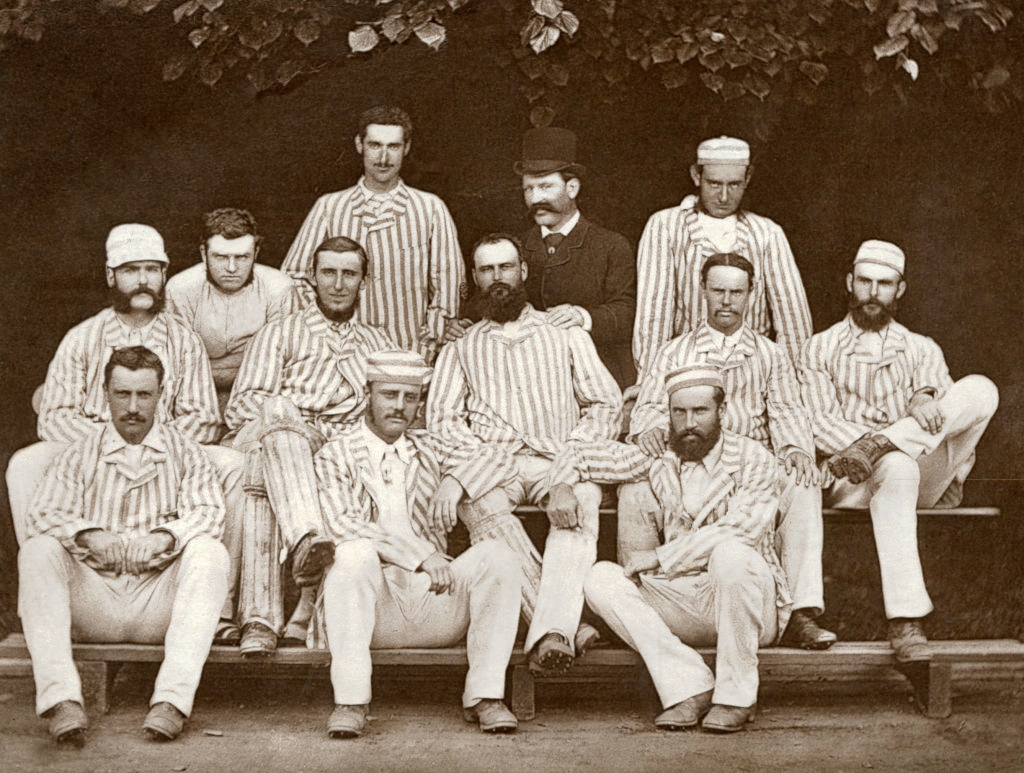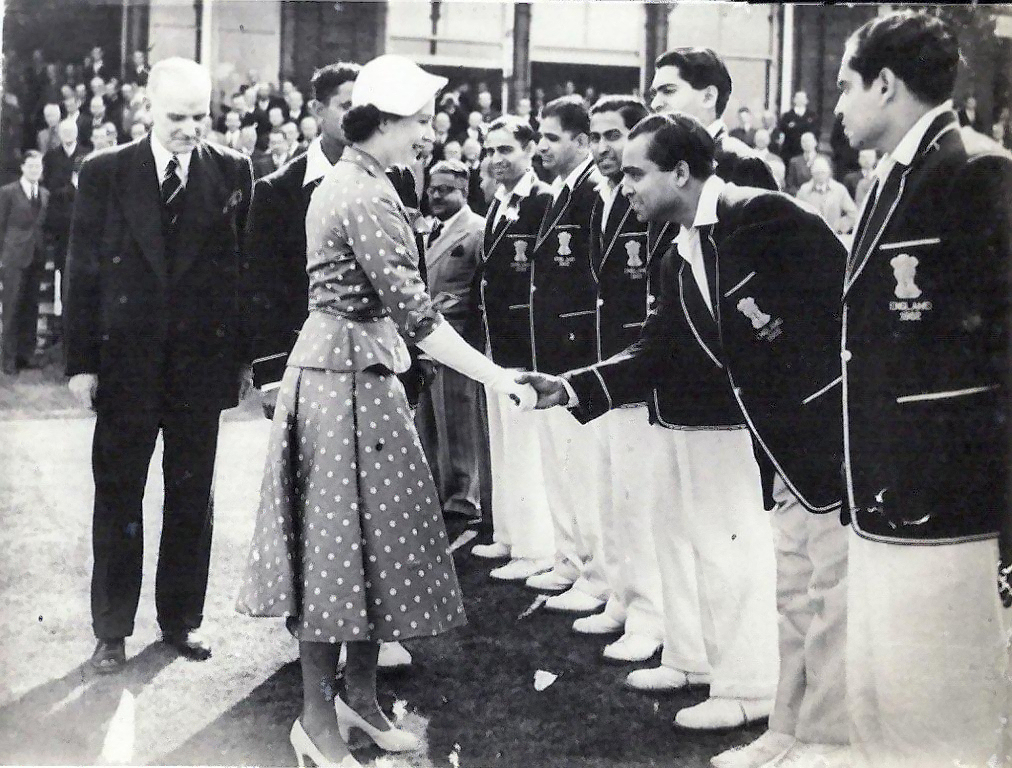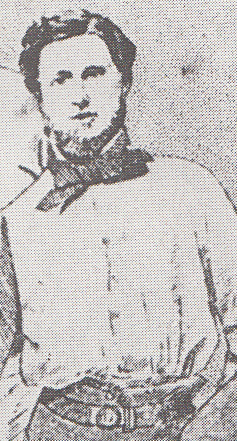|
Frank Allan
Francis Erskine Allan (2 December 1849 – 9 February 1917) was an Australian cricketer who represented Victoria cricket team, Victoria in first-class cricket, first-class intercolonial cricket in Australia, intercolonial matches and made one Test cricket, Test appearance for Australia cricket team, Australia. A tall, wiry left-arm fast bowling#Categorisation of fast bowling, medium pacer known by the sobriquet "The Bowler of a Century", Allan possessed great spin bowling, spin and a peculiar swerve which he claimed to have developed through his use of boomerangs and waddy, waddies growing up amongst Indigenous Australians, Aboriginal people in the Victorian the bush, bush. He was also given the nickname "Kangaroo" because he would jump like a kangaroo to celebrate taking a wicket. Allan began a lifelong association with the South Melbourne Cricket Club in 1866 when he played for the side in his first ever match. Winning the club bowling average that season, he was quickly recog ... [...More Info...] [...Related Items...] OR: [Wikipedia] [Google] [Baidu] |
Allansford
Allansford is a town in the Western District, Victoria, Western District of Victoria (Australia), Victoria, Australia. It is in the City of Warrnambool Local government in Australia, local government area. The Hopkins River flows through the town. Warrnambool Cheese and Butter is based in Allansford. History The Post Office opened on 1 January 1860 The Port Fairy railway line, railway through the town was opened in 1890, and the town was once served by a Allansford railway station, local railway station. Today A business park for Warrnambool is planned for the area. The town has an Australian Rules football team (the Cats) competing in the Warrnambool & District Football League. Allansford also hosts the final of the Sungold Cup. Which is a T20 competition consisted of they nearby leagues best teams. Population At the , Allansford had a population of 1,521. 85.0% of people were born in Australia and 89.9% of people only spoke English at home. The most common responses for ... [...More Info...] [...Related Items...] OR: [Wikipedia] [Google] [Baidu] |
South Melbourne Cricket Club
The Casey-South Melbourne Cricket Club is a cricket club located in the outer south-eastern Melbourne suburb of Cranbourne East, which plays in the Victorian Premier Cricket competition. Founded in 1862 as South Melbourne, it has produced nine Australian Test captains, more than any other cricket club in Australia. 47 international players have represented the club, eight of whom have been listed as a ''Wisden'' “ Cricketer of the Year”. The club played at the South Melbourne Cricket Ground in Albert Park until 1994, when the ground was redeveloped into a soccer stadium. At this point, the club considered merging with St Kilda, but this proposal was voted down by the members and instead the club moved onto the Harry Trott Oval, also located in Albert Park. Over the following decade, the club's finances waned and it was frustrated by the poor quality of the ground and a poor relationship with Parks Victoria; so, in 2005–06, the club relocated to the outer suburban Casey Fi ... [...More Info...] [...Related Items...] OR: [Wikipedia] [Google] [Baidu] |
James Lillywhite
James Lillywhite (23 February 1842 – 25 October 1929) was an English Test cricketer and an umpire. He was the first ever captain of the English cricket team in a Test match, captaining two Tests against Australia in 1876–77, losing the first, but winning the second. Lillywhite was born in Westhampnett in Sussex, the son of a brickmaker, John Lillywhite. In the 1861 census the 19 year old James' profession is given as Tile Maker. He was the nephew of William Lillywhite, and so cousin to William's sons, James Lillywhite senior, John, Fred and Harry. Lillywhite is termed "junior" in sources to differentiate between him and his cousin James senior. He became a professional cricketer, and played first-class cricket for Sussex from 1862 and 1883. He played one final first-class match in 1885. Before the pre-Ashes Test-playing tour to Australia in 1876–77, Lillywhite also joined tours to North America in 1868 in a team led by Edgar Willsher, to Australia in 1873–74 in a ... [...More Info...] [...Related Items...] OR: [Wikipedia] [Google] [Baidu] |
English Cricket Team In Australia And New Zealand In 1878–79
An English cricket team captained by George Harris, 4th Baron Harris, Lord Harris toured Australia and New Zealand in 1878–79 in a private tour organised by the Melbourne Cricket Club. The team's match against Australia national cricket team, Australia in January 1879 was retrospectively given Test cricket, Test match status, making it the third Test ever and the third between Australia and England cricket team, England, though it was not part of The Ashes which began in 1882. Harris' tour party arrived in Australia just two months after the touring Australians had returned from England. They were scheduled to play five tour matches, two each against New South Wales cricket team, New South Wales and Victorian Bushrangers, Victoria and one against the combined Australians. Whilst in Sydney, the notorious Sydney Riot of 1879 occurred as a result of the tourists match against New South Wales. The English team, which is sometimes referred to as Lord Harris' XI, also visited New Zea ... [...More Info...] [...Related Items...] OR: [Wikipedia] [Google] [Baidu] |
George Harris, 4th Baron Harris
Colonel George Robert Canning Harris, 4th Baron Harris, (3February 185124March 1932), generally known as Lord Harris, was a British colonial administrator and Governor of Bombay, best known for developing cricket administration via Marylebone Cricket Club (MCC). An English amateur cricketer, from 1870 to 1889, Lord Harris played for Kent and England, captaining both teams. He was President of the Kent County Football Association between 1881 and 1908, as well as serving as a government minister from 1885 to 1900. Early life The Honourable George Harris was born at St Ann's, Trinidad, on 3 February 1851, the only son of George Harris, 3rd Baron Harris, and his wife Sarah Cummins, daughter of George Cummins. At the time of his birth, his father was serving as Governor of Trinidad (1846–1854).Carlaw D (2020) ''Kent County Cricketers A to Z. Part One: 1806–1914'' (revised edition), p.216.Available onlineat the Association of Cricket Statisticians and Historians. Retrieved ... [...More Info...] [...Related Items...] OR: [Wikipedia] [Google] [Baidu] |
Melbourne Cricket Ground
The Melbourne Cricket Ground (MCG), also known locally as the 'G, is a sports stadium located in Yarra Park, Melbourne, Victoria. Founded and managed by the Melbourne Cricket Club, it is the largest stadium in the Southern Hemisphere, the List of stadiums by capacity, eleventh-largest stadium globally, and List of cricket grounds by capacity, the second-largest cricket stadium by capacity. The MCG is within walking distance of the Melbourne City Centre, Melbourne CBD and is served by Richmond railway station, Melbourne, Richmond and Jolimont railway station, Jolimont railway stations, as well as the Melbourne tram route 70, route 70, Melbourne tram route 75, 75 and Melbourne tram route 48, 48 trams. It is adjacent to Melbourne Park and is an integral part of the Melbourne Sports and Entertainment Precinct. Since it was built in 1853, the MCG has undergone numerous renovations. It served as the main stadium for the 1956 Summer Olympics and the 2006 Commonwealth Games, as well a ... [...More Info...] [...Related Items...] OR: [Wikipedia] [Google] [Baidu] |
Australian Cricket Team In England And North America In 1878
From May to September in 1878, an Australian cricket team made the inaugural first-class tour of England by a representative overseas side. In October, the Australians played additional matches in the US and Canada on their return journey. The tour followed one made by an England team to Australia in 1876–77, during which the first matches retrospectively given Test match status were played. None of the 1878 matches had international status, nevertheless the tour proved to be such an outstanding financial and sporting success that the future of international cricket was assured. The Australian team was managed by John Conway and captained by Dave Gregory. William Gibbes, who was a non-player, acted as the team's assistant-manager and secretary. Conway was a journalist from Geelong, Victoria while Gregory and Gibbes were both Sydney-based accountants working for the New South Wales Public Service. These three cricket enthusiasts were the architects of the venture. They and ... [...More Info...] [...Related Items...] OR: [Wikipedia] [Google] [Baidu] |
Professional Sports
In professional sports, as opposed to amateur sports, participants receive payment for their performance. Professionalism in sport has come to the fore through a combination of developments. Mass media and increased leisure have brought larger audiences, so that sports organizations or teams can command large incomes. As a result, more sportspeople can afford to make sport their primary career, devoting the training time necessary to increase skills, physical condition, and experience to modern levels of achievement. This proficiency has also helped boost the popularity of sports.Andy Miah Sport & the Extreme Spectacle: Technological Dependence and Human Limits' (PDF) Unpublished manuscript, 1998 In most sports played professionally there are many more amateur than professional players, though amateurs and professionals do not usually compete. History American football American football (commonly known as football in the United States) was professionalized in the 1890s as a s ... [...More Info...] [...Related Items...] OR: [Wikipedia] [Google] [Baidu] |
English Cricket Team In Australia In 1873–74
An England cricket team toured Australia in 1873–74. This was the third tour of Australia by an English team, the previous one being in 1863–64. The team is sometimes referred to as W. G. Grace's XI. Squad The team was captained by W. G. Grace (Gloucestershire) who was joined by Fred Grace, James Bush (both Gloucestershire); William Oscroft, Martin McIntyre (both Nottinghamshire); Harry Jupp, James Southerton, Richard Humphrey, Farrington Boult (all Surrey); Andrew Greenwood (Yorkshire); James Lillywhite (Sussex); W. R. Gilbert (Middlesex). The party consisted of five amateurs and seven professionals. Tour The team played 15 matches in Australia but none are recognised as a first-class fixture. . Retrieved on 12 July 2009. ... [...More Info...] [...Related Items...] OR: [Wikipedia] [Google] [Baidu] |
Cricket Statistics
Cricket is a sport that generates a variety of statistics. Statistics are recorded for each player during a match, and aggregated over a career. At the professional level, statistics for Test cricket, One Day International (ODI), and first-class cricket are recorded separately. However, since Test matches are a form of first-class cricket, a player's first-class statistics will ''include'' their Test match statistics – but not vice versa. Nowadays, records are also maintained for List A cricket, List A and Twenty20 matches. These matches are normally limited over games played domestically at the national level by leading Test nations. Since one-day internationals are a form of List A limited over matches, a player's List A statistics will ''include'' their ODI match statistics – but not vice versa. General statistics * Matches (Mat/M/Mts): Number of matches played. (also Played (Pl).) * Catches (Ct): Number of catches taken. * Stumpings (St): Number of stumpings made (as a w ... [...More Info...] [...Related Items...] OR: [Wikipedia] [Google] [Baidu] |
The Australasian
The ''Australasian Post'', commonly called the ''Aussie Post'', was Australia's longest-running weekly picture magazine. History and profile Its origins are traceable to Saturday, 3 January 1857, when the first issue of ''Bell's Life in Victoria and Sporting Chronicle'' (probably best known for Tom Wills's famous 1858 Australian rules football letter) was released. The weekly, which was produced by Charles Frederic Somerton in Melbourne, was one of several Bell's Life publications based on the format of '' Bell's Life in London'', a Sydney version having been published since 1845. On 1 October 1864, the weekly newspaper ''The Australasian'' was launched in Melbourne, Victoria by the proprietors of '' The Argus''. It supplanted three unprofitable ''Argus'' publications: ''The Weekly Argus'', ''The Examiner'', and ''The Yeoman'', and contained features of all three. A competitor, ''The Age'', gloated that as it was printed on coarse heavy paper, its weight exceeded the maximum f ... [...More Info...] [...Related Items...] OR: [Wikipedia] [Google] [Baidu] |
William Hammersley
William Josiah Sumner Hammersley (25 September 1826 – 15 November 1886) was an English-born first-class cricketer and sports journalist in Victoria, Australia, one of the four men credited with setting down the original rules of Australian rules football. Life Hammersley (1826-1886) was born on 25 September 1826 at Ash, Surrey, England to father William Josiah Hammersley of England. Hammersley was educated at Aldenham School and at a private school in Billericay. He matriculated at Trinity College, Cambridge, but did not graduate with a degree. During his teens he was a prominent cricketer having debuted at Lord's on 10 June 1847 as a batsman for Cambridge. He was also a prominent shooter and footracer. Hammersley migrated to Australia in 1856. Upon his arrival in Melbourne he became a member of the Melbourne Cricket Club. He first represented the colony of Victoria against New South Wales in the intercolonial cricked match at the Domain in January 1857 and was a regular ... [...More Info...] [...Related Items...] OR: [Wikipedia] [Google] [Baidu] |





